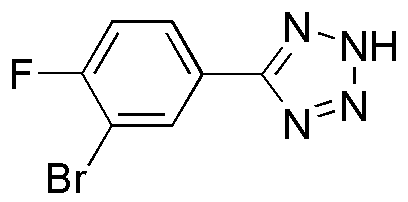5-(3-Bromo-4-fluorophenyl)-2H-tetrazole is widely utilized in research focused on
- Pharmaceutical Development: This compound serves as a key intermediate in the synthesis of various pharmaceuticals, particularly in the development of drugs targeting neurological disorders.
- Agricultural Chemistry: It is used in the formulation of agrochemicals, providing effective solutions for pest control while minimizing environmental impact.
- Material Science: The compound is incorporated into polymer blends to enhance thermal stability and mechanical properties, making it valuable in the production of durable materials.
- Analytical Chemistry: It acts as a reagent in analytical techniques, aiding in the detection and quantification of specific compounds in complex mixtures.
- Research on Chemical Reactions: This chemical is utilized in studies exploring reaction mechanisms, offering insights into the behavior of similar compounds under various conditions.
General Information
Properties
Safety and Regulations
Applications
5-(3-Bromo-4-fluorophenyl)-2H-tetrazole is widely utilized in research focused on
- Pharmaceutical Development: This compound serves as a key intermediate in the synthesis of various pharmaceuticals, particularly in the development of drugs targeting neurological disorders.
- Agricultural Chemistry: It is used in the formulation of agrochemicals, providing effective solutions for pest control while minimizing environmental impact.
- Material Science: The compound is incorporated into polymer blends to enhance thermal stability and mechanical properties, making it valuable in the production of durable materials.
- Analytical Chemistry: It acts as a reagent in analytical techniques, aiding in the detection and quantification of specific compounds in complex mixtures.
- Research on Chemical Reactions: This chemical is utilized in studies exploring reaction mechanisms, offering insights into the behavior of similar compounds under various conditions.
Documents
Safety Data Sheets (SDS)
The SDS provides comprehensive safety information on handling, storage, and disposal of the product.
Product Specification (PS)
The PS provides a comprehensive breakdown of the product’s properties, including chemical composition, physical state, purity, and storage requirements. It also details acceptable quality ranges and the product's intended applications.
Certificates of Analysis (COA)
Search for Certificates of Analysis (COA) by entering the products Lot Number. Lot and Batch Numbers can be found on a product’s label following the words ‘Lot’ or ‘Batch’.
Numéro de catalogue
Numéro de lot/série
Certificates Of Origin (COO)
This COO confirms the country where the product was manufactured, and also details the materials and components used in it and whether it is derived from natural, synthetic, or other specific sources. This certificate may be required for customs, trade, and regulatory compliance.
Numéro de catalogue
Numéro de lot/série
Safety Data Sheets (SDS)
The SDS provides comprehensive safety information on handling, storage, and disposal of the product.
DownloadProduct Specification (PS)
The PS provides a comprehensive breakdown of the product’s properties, including chemical composition, physical state, purity, and storage requirements. It also details acceptable quality ranges and the product's intended applications.
DownloadCertificates of Analysis (COA)
Search for Certificates of Analysis (COA) by entering the products Lot Number. Lot and Batch Numbers can be found on a product’s label following the words ‘Lot’ or ‘Batch’.
Numéro de catalogue
Numéro de lot/série
Certificates Of Origin (COO)
This COO confirms the country where the product was manufactured, and also details the materials and components used in it and whether it is derived from natural, synthetic, or other specific sources. This certificate may be required for customs, trade, and regulatory compliance.


